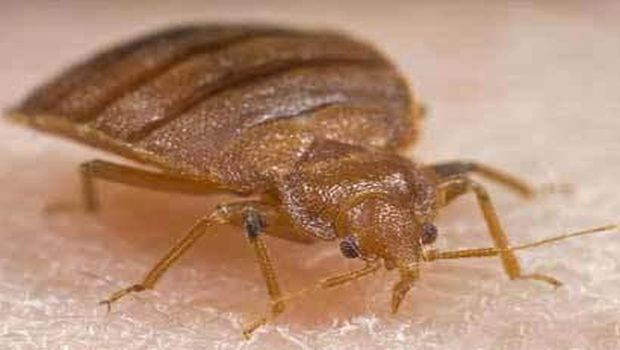Bed Bugs That Feed are More Likely to Survive Pesticide Exposure
Many studies have been conducted on how effective certain pesticides are when they are applied to bed bugs. However, most have not allowed the bed bugs to take a blood meal after being exposed to pesticides, which can change the mortality rates, according to an article in the Journal of Medical Entomology. Researchers from Rutgers University found that bed bugs that were allowed to feed after being treated with insecticides either had greater rates of survival, or they took longer to die than bed bugs that were not allowed to feed after being treated.


This is a bed bug feeding. Courtesy of Gary Alpert, Harvard University, Bugwood.org.
Many studies have been conducted on how effective certain pesticides are when they are applied to bed bugs. However, most have not allowed the bed bugs to take a blood meal after being exposed to pesticides, which can change the mortality rates, according to an article in the Journal of Medical Entomology. Researchers from Rutgers University found that bed bugs that were allowed to feed after being treated with insecticides either had greater rates of survival, or they took longer to die than bed bugs that were not allowed to feed after being treated.
"Our results indicated that post-treatment feeding significantly reduced or slowed down bed bug mortality," the researchers wrote.
In one case, bed bugs that were unable to feed after being sprayed with an insecticide had a mortality rate of 94 percent. But bed bugs that did feed after being sprayed with the same insecticide had a mortality rate of just 4 percent after 11 days.
This difference is important because most experiments that test the efficacy of insecticides against bed bugs are performed in labs where the bed bugs can't feed after being exposure. However, in the field, bed bugs can feed after being treated with an insecticide, and the reduced or slowed mortality could give them a chance to reproduce.
"Many of the insecticides labeled for bed bug control may not be as effective as claimed, because of the inadequate testing method," says Dr. Narinderpal Singh, one of the co-authors. "People often use laboratory bioassay results to predict field performance of an insecticide. It is important the testing conditions are similar to what would occur in the field. Current established test protocols for bed bug insecticides do not provide bloodmeals to bed bugs during the test period. We suspect the mortality data typically observed might be different if the tested bed bugs were provided a bloodmeal during the observation period."
The researchers suggest that feeding "stimulates detoxification enzymes responsible for insecticide resistance," which is why more bed bugs survive after taking bloodmeals, so using insecticides in tandem with other control methods is the best option.
"Incorporating non-chemical methods into bed bug control is very important in order to achieve good results," says Singh. "Some examples of non-chemical methods include vacuuming visible bed bugs, applying steam to furniture and baseboards, laundering bed sheets and infested clothing, encasing mattresses and box springs with bed bug encasements, and installing interceptors under the legs of beds and upholstered furniture."
The researchers also suggest that insecticide efficacy testing protocols should be changed so that they include using recently fed bed bugs, and that bugs that are fed one to three days after being exposed to pesticides.
The full article, "Posttreatment Feeding Affects Mortality of Bed Bugs (Hemiptera: Cimicidae) Exposed to Insecticides," is available HERE.
Source: Entomological Society of America
Newsletter
Stay prepared and protected with Infection Control Today's newsletter, delivering essential updates, best practices, and expert insights for infection preventionists.